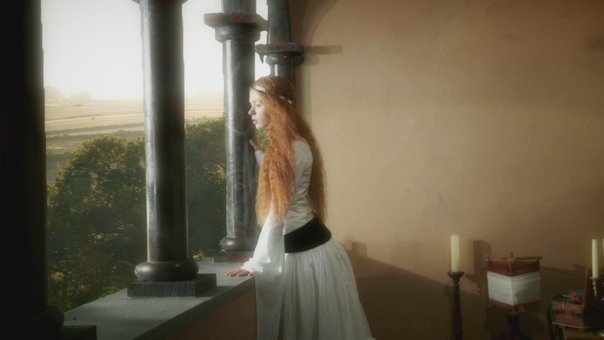

 The Raven
The Raven  Church Going
Church Going  Frost at Midnight
Frost at Midnight  I sit & look out
I sit & look out  The Lady of Shallot
The Lady of Shallot  Telephone Conversation
Telephone Conversation  Going Places
Going Places  Village Cricket Match
Village Cricket Match  The Night Train at Deoli
The Night Train at Deoli  Growing Up
Growing Up  The Castaway
The Castaway 
 Download as PDF
Download as PDF

(Continued from Page 1)
The appearance of Sir Lancelot-one of the most courageous knights of King Arthur has been portrayed by the poet in a remarkable manner through brilliant imageries. The flashing image of Sir Lancelot is in stark contrast to the grey and dull image of the Lady of Shallot.
He came through the barley fields proceeding towards Camelot, glazing and dazzling, every bit of his polished brazen armour shone in the sunshine. The poet says that the glittering image of the bridle encrusted with gems, seemed like the Milky Way galaxy. His bugle clanged against the armour while the bells rang merrily, symbolizing his cheerful mood. His helmet and the feather on it flashed like fire as he passed her window. On his sparkling shield, was a carving of a knight kneeling before a young Lady.

He galloped alongside the remote island of Shallot in the clear blue sky. The shining jewels on his saddle and his entire brilliant image made him look like a meteor in the evening sky.
The lady of Shallot became completely spell-bound and captivated by the electrifying appearance of Sir Lancelot and fell in love with him at the first sight. She could no longer restrain herself and leaving her web and loom, took three steps to look down straight at Camelot.

The poet now uses sharp short sentences to show some action in her inactive life and brings out the tragedy of the curse effectively. The bright colours of the previous stanzas become dark and ominous while the atmosphere abruptly changes to one of gloom and mourning. The woods turned pale and weary in the storm that had started all of a sudden and the east wind struggling hard against it. The skies broke out in rain and storm and the river too began to moan, as if complaining against the sudden change.

The poet says that the lady of shallot was completely aware of her impending doom and just as a prophet or a man endowed with wisdom and vision foresees his own misfortune gradually approaching him but never loses his courage, the lady of Shallot too knew the source of her all her disaster and kept gazing at Camelot in a trance. She descended from her tower and found a boat and loosening the chain she lay in it. The currents moved it slowly towards Camelot while the lady of Shallot, dressed in a loose snowy white gown, sung her last song- a soft, low and mournful tune. As the boat floated between the hills covered with willow trees and fields, her body gradually froze and the lady finally died even before reaching the first house on the shore of Camelot. The boat carrying her shinning dead body continued to float near the towers, galleries and garden walls of the city, finally reaching the royal feast.

The poem ironically ends with an atmosphere enveloped with silence, sorrow and curiosity as Sir Lancelot, who was also present at the banquet, remarking rather casually-

Oblivious to the truth that he had been the prime cause for her death.


 Download as PDF
Download as PDF